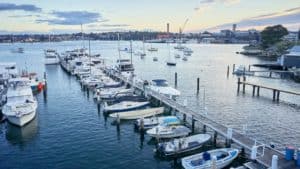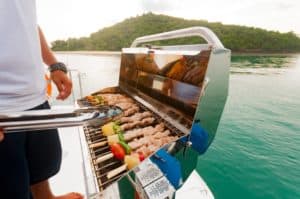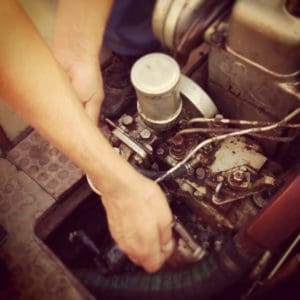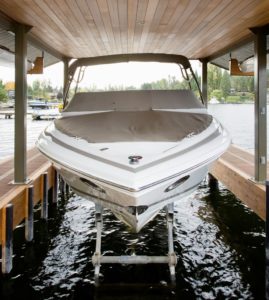If you plan to keep your boat on the water, learning how to properly moor your vessel is important to ensure you secure your boat safely.
Here are some of the ways you can safely moor your boat.
Anchoring with a Mooring Buoy
A mooring buoy floats on the surface of the water and is connected to a large, heavy anchor permanently attached to the seabed. It provides a place to safely secure your boat for an extended period of time.
Here are the steps you should take to properly secure your boat to a mooring buoy.
- Shorten your dinghy painter so that the dinghy is right behind your stern and the painter is not trailing in the water.
- Prepare a bridle to put through the eye of the mooring line and fasten it to one of the bow cleats.
- Have a crew member grab the hook and stand on the bow. They will use hand signals to guide you to the buoy.
- Approach upwind and reduce speed early enough that you won’t go past the buoy.
- A crew member will grab the mooring line, pass the bridle line through the eye of the mooring line and secure the other end of the bridle to the other bow cleat.
During severe weather events, it is recommended to tie a second line directly between your boat and the mooring buoy itself. It’s also good practice to check the mooring line to makes sure it is in good condition and not too chafed.
Long Line Mooring
Long line mooring involves anchoring your boat and then tying up a long line from the stern to something sturdy offshore such as a tree or a big rock.
Rigging the long line ashore is much easier when you have at least two other crew members on board. One crew member can stay on the bow and help with the anchor while the other goes in the dinghy with the long line.
Start by explaining the plan to the crew and preparing the boat. Rig your fenders on both sides of the boat and get your long line ready in the cockpit.
The next step is to find a good spot to moor. Look for a sturdy rock or tree that is reachable with your long line. The crew on the dinghy will then go ashore with the long line and tie it to the rock or tree.
After securing the long line, the crew will go back on the dinghy and bring the long line to you. You can now deploy the anchor and start reversing the boat. After you have dropped enough chain, the crew on the dinghy will approach the boat and hand you the long line.
Attach the long line to your windward quarter and the boat should now be secure. If you want, you can also rig a second long line from the leeward quarter to another object offshore. This will provide extra stability in the event of wind changes.
Stern to Berthing
Stern to Berthing, is one of the most common mooring techniques. Instead of coming alongside a slip or pier beam-to, you tie the boat stern-to at a right angle to the jetty.
1. Assess the Situation
Before entering the harbor, stow any dinghies on deck as they will get in the way and present a damaging hazard.
As you come into the harbor, circle around a few times to get a better understanding of the surroundings and water activities
2. Prepare the Boat and Crew
After you find a space, inform the crew of your plans, and assign them to different stations.
Placing fenders on each side of the boat can help prevent damage to your boats and others as you come alongside them on your way to the Marina.
Prepare the docking lines on the aft quarters and have them ready to run ashore. Your lines should be long enough to reach around or through the bollard or cleat on the dock and double back to your aft-quarter cleats.
Lead one end of each line outside stanchions and lifelines then through the stern chocks to your stern-quarter cleats. You’ll then secure the lines to the cleats using either a cleat hitch or a bowline loop.
3. Maneuver Boat Into Position
Next, you will assess the wind direction and start to maneuver. If there is a lot of wind or current on your port or starboard side, you want to be upwind or up-current so that the wind will align you with your chosen space as you back in.
With the boat about seven boat lengths away from the dock, and the stern pointing toward the space you want to use, have the bowman pay out the anchor chain until the hook is hanging about three feet above the bottom. Slowly begin backing toward the dock, and slowly pay out more rode.
As the anchor skims the bottom, have the bowman pay out the rode as the anchor digs in. At the helm, use a quick burst of reverse to set the anchor. Once the hook is set, have the bowman resume evenly paying out rode as you back in.
When you are about four feet away from the quay, be prepared to deploy lines. Have one crew member on each side throw a manageable amount of line and then quickly pay out the rest to the person assisting on the dock.
The person on the dock should secure the windward line first, passing it around the dock bollard or through the dock cringle before tossing it back to a crew member aboard. Once the windward line is secured to a stern cleat, deploy the leeward line using the same technique.
Moor Your Boat at Corleone Marinas
Corleone Marinas offers premium harbor experiences across Sydney, including locations in Sydney’s most prestigious sites including Elizabeth Bay, Long Island, Balmain and Drummoyne. Each site offers a variety of options including berths, moorings, on-site slipways and shipwrights.
If you need maintenance or repairs for your vessel due to corrosion, we can help! Contact us today to learn about our full range of marina services.






